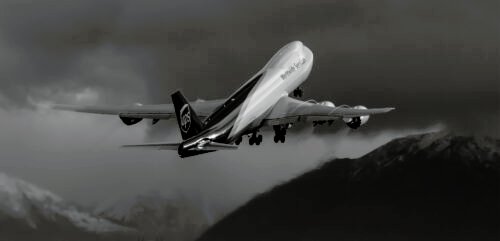
Black and White photography-
The gray skies over the Alaska landscape the Ted Stevens Anchorage International Airport are to me an invitation to make black and white images. The mighty roar of the engines and the contrast of the Cargo jets to the sky above is a challenge. I try to make dynamic images of aircraft in flight and on the ground.
Making a good contrast black and white image is an art which Edward Weston and Ansel Adams perfected in the early 1900s. While these images taken on digital media there are adjustments that you can make to craft a good rendition in Black and White. More on that later.
Black and white photography was my first passion as a photographer. Learning to process 2 1/4 X 3 ¼ inch sheet film in rubber tanks, and then 35 mm film in NIKKOR stainless reels and tanks was a wonderful way to experiment with development times and temperatures. Making prints are conducted in the darkroom but with the use of special low wattage filtered lights enclosed in a reflector box. Darkrooms were not equipped with red lights but with a brownish safelight so that you could watch as your prints come up in the developer tray. These safelights were specific to photographic papers and not used with film.
The only time I ever used a red safelight with film was when I was experimenting with orthographic films which when developed in special chemistry that makes extreme contrast images (black and white no grays).

Learning Black and White Processes-
After trying my hand, a making prints in my makeshift darkroom (only used at night) I started to experiment with printing trying to get good contrast, shadow detail and highlights. My guide were the images of Yosemite in a book given to me one Christmas by Loretta Fox a teacher who loved Yosemite Park. The Yosemite images made by Ansel Adams inspired my imagination. I read, tried different ASA (now ISO) films and expensive silver halide photographic papers trying to emulate those landscapes but I just could not make it happen. Good black and white photographs are made with multiple considerations with the use of a Zone System for exposures, equally important is processing the film to obtain good shadow detail and highlights in prints that have detail and are not blown out (overly white).
My father was my best critic, offering advice about contrast, black, grey, and white prints. He too had been interested in photography and was a tremendous help getting me on the right track. It was clear that large format view cameras with super sharp lenses and tripods would were necessary to continue. Way out of my realm in price I returned to the 35mm single lens reflex camera.
My high school chemistry teacher had a 35mm Exacta which he loaned me to use during school hours. He also showed me my first real darkroom near the chemistry labs on the upper level of the school. I obtained permission to use the darkroom after school hours and did so many times. This led to becoming the High School newspaper photographer and later to Yearbook photography which allowed me to take part during class hours when unique events and sports were in session. Soon a 35mm Praktica VF single lens camera and lens showed up under the Christmas tree and I was thrilled. No more Yashica 2 ¼ X 2 ¼ inch roll film, twin lens cameras for me.

Working as a Photographer
Later I worked as a photojournalist and a lab man for a newspaper processing film, making contact sheets for the editors to choose the next editions images. Moving on in my career I did my own processing and printing for newspapers shooting spot news, sports and feature picture stories. I also entered contests and mounted the contest submission images on 16X20 exhibit boards.
Now with the advent of digital color cameras, black and white images are more of an Avant Garde or art form by artists and photographers expressing their ideas and vision of their world. We call this “seeing.”

Suggestion for Digital Black and White images–
My experience with black and white digital prints and files are that when done correctly are fabulous. Far better than those of the past. To circumvent poor printing or super expensive photo printing I use the following adjustments for digital images (jpeg only).
To achieve the best B+W imagery I under expose by 2/3 of stop and instead of using the monochrome settings on the camera or Photoshop’s Image Mode (gray) I use the File Edit in Photoshop. Go to Image-Adjustments-Hue and Saturation and remove the color until you achieve the tones you like. I usually make a copy image and experiment with the copy. Be sure to check the Levels after the Image adjustments in Photoshop and adjust the white and blacks in Levels to ensure your final image has the tonality for which you are striving. There are also apps and software to enhance your B+W digital photography.
Here are few recommendations for software tools:

